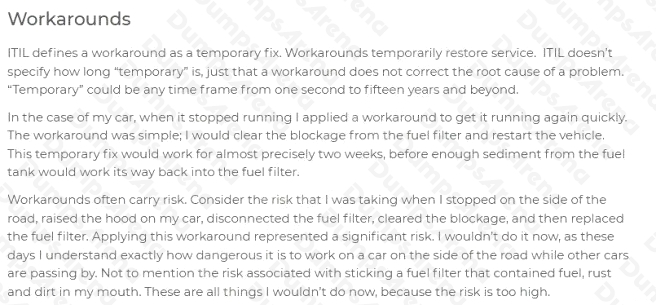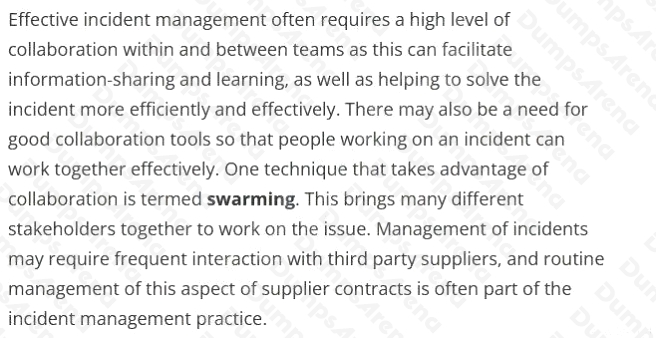ITIL itilfnd-v4 practice test
ITIL 4 Foundation
Last exam update: Jul 20 ,2024
Question 1
When should a workaround be created?
- A. As soon as possible, once the incident is logged
- B. After the resolution of a problem
- C. When a problem cannot be resolved quickly
- D. When a potential permanent solution has been identified
Answer:
C
Explanation:
Reference: https://www.globalknowledge.com/us-en/resources/resource-library/articles/incidents-and-problems-
workarounds/
Question 2
Which is a key requirement for successful service level agreements (SLAs)?
- A. They should be based on system-based metrics which are useful to the service provider
- B. They should be written using language and terms which all parties will understand
- C. They should be carried forward, unchanged, from one year to the next to enable consistent service
- D. They should avoid ambiguous targets such as those relating to user experience
Answer:
B
Question 3
What is a service?
- A. A possible event that could cause harm or loss, or make it more difficult to achieve objectives
- B. A means of enabling value co-creation by facilitating outcomes that customers want to achieve, without the customer having to manage specific costs and risks
- C. A tangible or intangible deliverable of an activity
- D. Joint activities performed by a service provider and a service consumer to ensure continual value co-creation based on agreed and available service offerings
Answer:
B
Explanation:
Reference: https://www.bmc.com/blogs/itil-key-concepts-service-management/
Question 4
Which statement about problems is CORRECT?
- A. Problems are not related to incidents.
- B. Problems must be resolved quickly in order to restore normal business activity.
- C. Problem analysis should focus on one of the four dimensions to achieve a fast diagnosis.
- D. Problem prioritization involves risk assessment.
Answer:
B
Explanation:
Reference: https://www.bmc.com/blogs/itil-problem-management/
Question 5
Which activity is NOT recommended by the ‘start where you are’ guiding principle?
- A. Applying risk management when considering to introduce new processes
- B. Discarding existing processes before assessing their usefulness
- C. Involving people who are not familiar with a service when observing and assessing its activities
- D. Using service data to avoid any unintentional data distortion found in reports
Answer:
B
Question 6
What varies in size and complexity, and uses functions to achieve its objectives?
- A. A risk
- B. An organization
- C. A practice
- D. An outcome
Answer:
B
Question 7
What includes governance as a component?
- A. Practices
- B. The service value chain
- C. The service value system
- D. The guiding principles
Answer:
C
Question 8
Which practice improves customer and user satisfaction by reducing the negative impact of service interruptions?
- A. Service request management
- B. Service level management
- C. Incident management
- D. Change enablement
Answer:
C
Question 9
Which dimension includes the knowledge needed for the management of services?
- A. Organizations and people
- B. Value streams and processes
- C. Information and technology
- D. Partners and suppliers
Answer:
C
Question 10
Which practice uses technologies such as intelligent telephony systems, a knowledge base and monitoring tools?
- A. Service configuration management
- B. Service desk
- C. Problem management
- D. Deployment management
Answer:
B
Question 11
Which helps to manage an incident when it is unclear which support team should be working on the incident?
- A. Disaster recovery plans
- B. Swarming
- C. Target resolution times
- D. Self-help
Answer:
B
Explanation:
Reference: https://www.bmc.com/blogs/itil-incident-management/
Question 12
Which practice includes the use of approaches such as Lean, Agile and DevOps with the aim of facilitating a greater amount
of change at a quicker rate?
- A. Service desk
- B. Monitoring and event management
- C. Service level management
- D. Continual improvement
Answer:
C
Question 13
Which is a purpose of release management?
- A. To protect the organization’s information
- B. To handle user-initiated service requests
- C. To make new and changed services available for use
- D. To move hardware and software to live environments
Answer:
C
Question 14
Which guiding principle discourages ‘silo activity’?
- A. Focus on value
- B. Start where you are
- C. Collaborate and promote visibility
- D. Keep it simple and practical
Answer:
C
Question 15
When is the earliest that a workaround can be documented in ‘problem management’?
- A. After the problem has been logged
- B. After the problem has been prioritized
- C. After the problem has been analyzed
- D. After the problem has been resolved
Answer:
C
When a problem cannot be resolved quickly